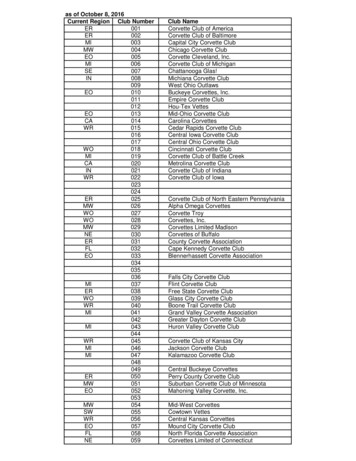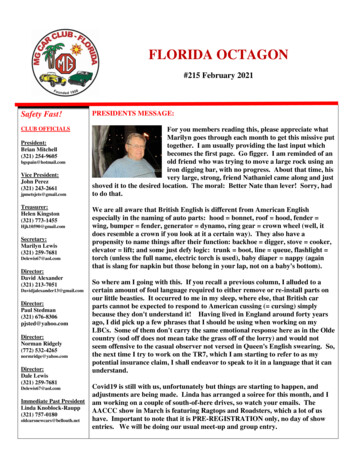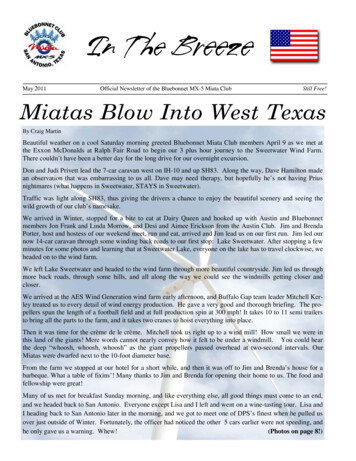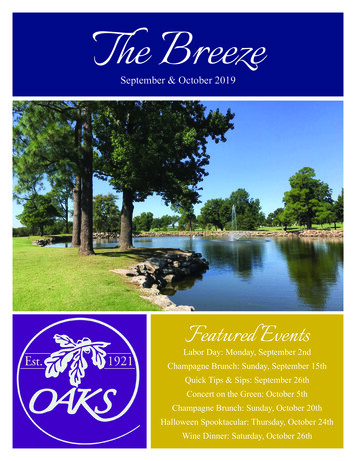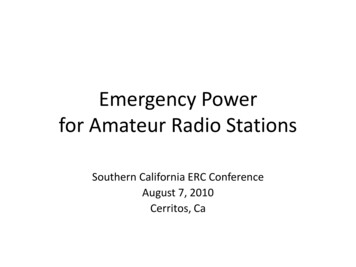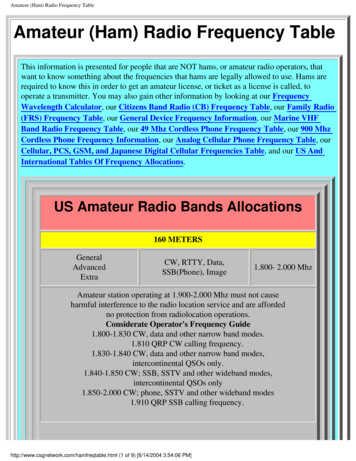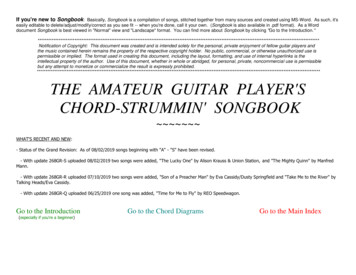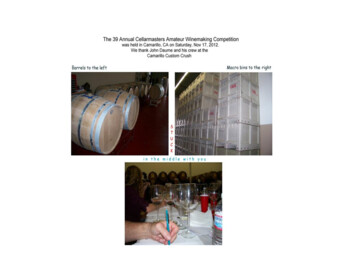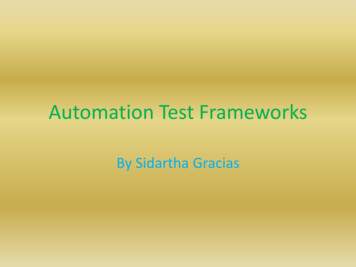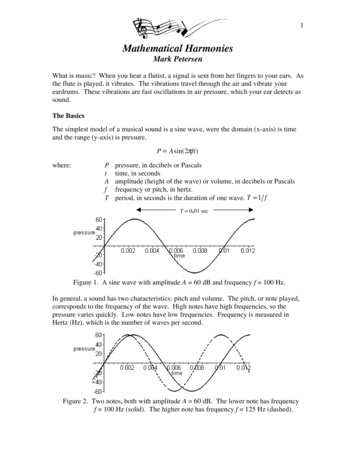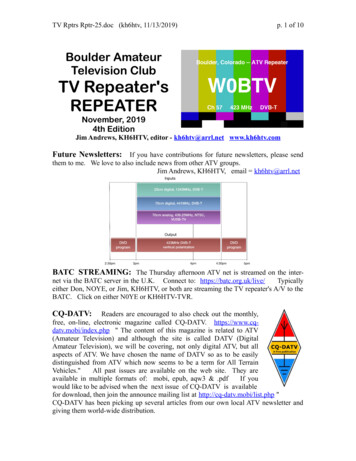
Transcription
TV Rptrs Rptr-25.doc (kh6htv, 11/13/2019)p. 1 of 10Boulder AmateurTelevision ClubTV Repeater'sREPEATERNovember, 20194th EditionJim Andrews, KH6HTV, editor - kh6htv@arrl.net www.kh6htv.comFuture Newsletters: If you have contributions for future newsletters, please sendthem to me. We love to also include news from other ATV groups.Jim Andrews, KH6HTV, email kh6htv@arrl.netBATC STREAMING: The Thursday afternoon ATV net is streamed on the internet via the BATC server in the U.K. Connect to: https://batc.org.uk/live/Typicallyeither Don, NOYE, or Jim, KH6HTV, or both are streaming the TV repeater's A/V to theBATC. Click on either N0YE or KH6HTV-TVR.CQ-DATV:Readers are encouraged to also check out the monthly,free, on-line, electronic magazine called CQ-DATV. https://www.cqdatv.mobi/index.php " The content of this magazine is related to ATV(Amateur Television) and although the site is called DATV (DigitalAmateur Television), we will be covering, not only digital ATV, but allaspects of ATV. We have chosen the name of DATV so as to be easilydistinguished from ATV which now seems to be a term for All TerrainVehicles."All past issues are available on the web site. They areavailable in multiple formats of: mobi, epub, aqw3 & .pdfIf youwould like to be advised when the next issue of CQ-DATV is availablefor download, then join the announce mailing list at http://cq-datv.mobi/list.php "CQ-DATV has been picking up several articles from our own local ATV newsletter andgiving them world-wide distribution.
TV Rptrs Rptr-25.doc (kh6htv, 11/13/2019)p. 2 of 10------- ELECTION DAY, 5 Nov. -----------Bill, AB0MY, and wife, Mary made news in the Boulder Daily Camera newspaper. Herethey are voting in the recent election. 40 -- 50 kHz to 900 MHzVECTOR NETWORK ANALYZEROn the Nov. 7th, ATV net, Colin,WA2YUN, showed us his new hand-heldVector Network Analyzer (VNA).Hewas astonished at the low, low price. Heonly paid 40. Colin says it will measureboth S11 and S21 and would be great asan antenna measurement tool for 70cmATV antennas. Specs. are 70dB range upto 300 MHz and 40dB to 900MHz.-13dBm rf output. 101 data points. Youcan export via USB Touchstone (.snp) files from it for use in other simulation softwareprograms. It includes an SMA calibration kit, USB cable and a battery. It is available onAmazon and E-Bay from several vendors. The prices vary with the lowest being about 40. There is a review of it on www.rtl-sdr.com Also there are YouTube videos postedabout it. Want still more info -- contact Colin.NEW 200 MHz OscilloscopeLooking for a new piece of testequipment for your ham shack? Rigoljust announced a 200 MHz, dualchannel scope for the low price of only 370. I paid that much for my Siglent,70 MHz scope.If this new scopeworks as well as Rigol's spectrumanalyzer, then this is a great buy.
TV Rptrs Rptr-25.doc (kh6htv, 11/13/2019)p. 3 of 10KD6ILO Portable, AM/FM, ATV RepeaterReport from San Diego / Oceanside, California - ATV ActivitesThank you Jim, for a very interesting and informative newsletter. 1st- My work at myC&E labs has picked up as I forecasted last month. So my ATV activities are put on theback burner. But I did have sometime to fire up my 15 year old AM FM X-Band ATVRepeater and has been placed on my home shop bench. The only adjustments were to the70cm AM modulator, other then that its working as it should be along with its' MirageATVN D1010 PA. The {Singapore}70cm digital upgrade package is still underevaluation and the internal frequency adjustments for Amateur US TV frequency's will beset soon. The package already comes with a built in PA which is adjustable via a GUIinterface as well as for frequency set up. Three bands 13cm 23cm 70cm are available withthis unit. Their are some extra benefits that go along with this package. more to come.2nd- We have also upgraded one of the controllers computer with a better processor forhandling tasking's as part of its' daily maintenance routine each day. When the system{repeaters} aren't in used the modulators power down to its' lowest output setting. Whenit receives a signal on an input it will transmit to it's normal set output level. Inputs viaRF or IP network adapter connection. We also added a {AREDN}IP phone line extensionin to the audio mixer which works out really well for our local AREDN coordination.Well that's my report for know and I hope everyone has a great week ahead and I'll seeyou all on Amateur Radio TV.73 de Mario KD6ILO
TV Rptrs Rptr-25.doc (kh6htv, 11/13/2019)p. 4 of 10KD6ILO Future 2020 ProjectDAYTON, OHIO -- ATV ACTIVITESWe have essentially nine active ATVers within normal line of sight distance from theDARA - W8BI ATV repeater. We have another group of ATV hams that I am also activewith and as a consequence this other group ends up being DX that comes into the repeaterfrom five other regular ATVers during frequent band enhancements and those guys arelocated in Mt. Giliad 80 miles, Maringo, 84 miles, Cincinnati, 60 miles, Hebron Ky 62miles and Powell Ohio about 70 miles. Usually about twice a year or so , there is oneother ATVer, W4HTB, in Bowling Green, KY who gets into the repeater at about 230miles out.My concept for the repeater has been more in line with using it as a DX window sinceATV interest had been taking a popularity nose dive until relatively recently. So therepeater has been very useful for that purpose until interest has started to re-blossom.Most recently, ATV is picking up in the area and I continue to try to fan the flames.There is an HF ATV DX group which meets daily on 75 meters and although myantennas are essentially attached to a mast that is sunk into a five gallon bucket ofcement, I have fun trying to work DX. I live in an HOA.drats!!! Since I still work fulltime, my DX participation has to wait for the weekends.I installed all of the digital gear at the site and I have upgraded the analog amplifiers andmost of the analog equipment. We have been running DVB-T since 2014 at the site.This particular repeater has been active for many years.Dave, AH2AREditor's note: Back in Ohio & the “Midwest” they have a much more humid climate andthus have “tropo” openings for long, multi-hundred miles of ATV-DX. Tropos don’t
TV Rptrs Rptr-25.doc (kh6htv, 11/13/2019)p. 5 of 10happen out here in the arid western part of the US. But - we do have very tall mountainsthat they don't have. So we are lucky afterall !HF ATV-DX NET: The DX group meets at 0730 local Eastern Time or directly afterthe Christian net on 3.930 MHz every day. Most of the DX stations stream their shackvideo so you can also see your ATV signal coming into their receivers via their individualstreaming pages on BATC. If you go to BATC streaming and look for WB8LGA’sstreaming page, you can check in on his texting window and he can further direct you tohis website. That provides a means to watch everyone’s stream on a single page. This is amid-west, regional activity due to typical 75 meter propagation effects and also ATVpropagation.Dave, AH2ARPARABOLIC DISH ANTENNASDon, N0YE, has submitted an article on measuring the gain of some of his microwaveantennas, including parabolic dish antennas. Wikipedia has an excellent tutorial on dishantennas. https://en.wikipedia.org/wiki/Parabolic antenna The equation for the gain ofsuch an antenna is:Where A is the area, d is the dish diameter, λ is the wavelength, andeA is the aperatureefficiency. eA determines how well the feed antenna fills the dish and it typically variesfrom 50 to 70%. G is a numerical value, not in dB. Note: the important concept for adish is the ratio of diameter to wavelength, squared. Don uses this equation to comparehis antenna measurement results.If you are interested in learning more about such antennas, or antennas in general, consultwith our local antenna expert, Prof. Ed Joy, K0JOY. Ed is a regular on our ATV weeklynets. This would be a good topic for an in depth discussion on a future ATV net.Microwave Antenna TestsDon, N0YE5.7 GHz ANTENNAS: The test frequency was 5678 MHz. The source antenna wasa 13 inch dish with a log periodic antenna constructed on a circuit board and made byKent Britain, WB5VJB, as the feed. The antenna test range was 70 feet. The sourceantenna was 10 inches off the ground and the antenna under test were 61 inches off theground.The reference antenna for the test is a Radiowaves SP1-2/5 dual band antenna that is 12inches in diameter. The published gain for the lowest measured frequency of 5750 MHzis 23.2 dBi. The gain for this antenna rose slightly at higher frequencies. Because thetests were run at 5678 MHz, the antenna gain for the test will be assumed to be 23.0 dBi.
TV Rptrs Rptr-25.doc (kh6htv, 11/13/2019)p. 6 of 10Don, N0YE's, 5.7 GHz source (left photo) consists of ADF-4351 frequency synthesizer,Frequency West brick 6 GHz LO, diode mixer, amplifier & PIN modulator (1kHz squarewave). Receive setup (right photo) with antenna under test on tripod, diode detector &HP VSWR meter (1kHz voltmeter).The antennas tested are in the table below. The table has the antenna tested with theobserved gain in dBi. The second column in the table has the measured antenna aperturein square inches. The next column shows the ratio of aperture to the Radiowaves antenna.That ratio then is shown as a number in dB. The final column computes what the testedantenna gain could be by adding the aperture ratio in dB to the gain of the referenceantenna.Dish Antennas: 13" dish with log-periodic feed (left), 13" dish with dipole& disc reflector feed (middle) & 20" dish with log-periodic feed (right)The 13 inch dish had twodifferent feeds tested. One feedwas a home brew (HB) feed thatwas a driven dipole element witha back splash plate one quarterwave behind the driven element.The second feed was a WA5VJBlog periodic antenna. The home
TV Rptrs Rptr-25.doc (kh6htv, 11/13/2019)p. 7 of 10brew feed was surprisingly close to the compted gain for the dish. Although the WA5VJBantenna feed came up a little short of the computed gain for the dish, it is a reasonablefeed to use when another antenna may be needed.The 20 inch dish antenna is a Dish Network 500 dish. This dish worked with two LNBswhich says the surface is not a section of a parabola but some other shape that wasdesigned to serve the two LNBs, and is less efficient per surface area than a parabolicsurface. The first generation Dish Network dishes were 18 inch dishes with a single LNBand had a surface that is a section of a parabolic surface. This 20 inch dish is a latergeneration of Dish Network dish. So thus in my opinion this is a dark horse as how tocharacterize it. The feed for this dish was a WA5VJB log periodic antenna. The gain isgood and makes the dish an asset when another antenna is needed.AntennaRef Dish13 in HB13 in VJB20 in dishGaindBi23.021.920.323.6ApertureSq. Inches113133133314ApertureRatio1.181.182.92Ratio indB0.70.74.6ComputedGain , dBi23.723.727.610 GHz ANTENNAS:My 10 GHz antennas were compared. on two antennaranges. The first was at close range of 29 feet separating the source antenna and theantennas under test. The second antenna range was over a distance of 70 feet that waslong enough for the source antenna to be in the far field of the antennas under test. Theheight of the source antenna and the height of the antennas under test were adjusted foreach test range for a satisfactory gain measurement. Interestingly these heights h1 and h2,for the source antenna height and test antenna height were computed and did not comparewith what actually was found to be needed on each antenna range test.The test frequency was 10368 MHz. The source antenna was a 17 dBi, waveguide horn.The standard gain, waveguide horn was a Narda 16.5 dBi gain antenna. This was theantenna used as a reference for the other antennas tested. The antennas test results are inthe table below.I have two Dish Network dishes. The 10 GHz dish is 18 inches and has a feed that housedthe LNB and was modified to be just the feed by adding an SMA probe into the waveguide. The 20 inch dish is what requires a feed and was used for 5.6 GHz.All computed gain numbers compare well to the observed gain with the exception of the13 inch dish. This dish has a home brew feed which is not performing as well as itcould/should. The antenna range testing was done in part to get a handle on how well the13 inch dish and feed perform. The home brew horn antenna was only tested on theshorter range and so the measured gain may not be accurate (below what it may be).
TV Rptrs Rptr-25.doc (kh6htv, 11/13/2019)p. 8 of 10AntennaGain AperturedBiSq. InchesApertureRatioRatio indBComputedGainNarda HB Horn12 in dish13 in dish18 in 2429303233.8113133225 (est)Editor's Note: The pc board, log-periodic antenna, less coax cable, can be purchased for 9 direct from Kent, WA5VJB. For more info, check out his web site for this and othermicrowave antennas, www.wa5vjb.com 25 ATV INTRODUCTIONWant to get into Amateur TeleVision (ATV) and not spend many bucks ? How aboutspending only 30 ? Interested?We can thank the huge popularity these days ofdrones for making it possible. The drone buzzword to find really inexpensive video gearis FPV, which stands for "First Person View". These days many drone pilots areinstalling a miniature TV camera onboard their drone and then transmitting the TVpicture to a ground receiver so they can watch in real-time what their drone is seeing.Google FPV and you will be amazed at the number of hits you get.Most of the drone FPV gear today uses the 5.8GHz band with FM-TV modulation. The5.8GHz, or 5cm, amateur band covers from 5.65 to 5.925 GHz. It should be noted thatthis is another band shared with unlicensed, ISM transmitters. The ISM band is 150 MHzwide from 5.725 to 5.875 GHz. This is why all the unlicensed drone FPV activity is alsofound at 5.8 GHz, along with Wi-Fi, etc.I have recently purchased some inexpensive 5.8GHz FPV transmitters and f
The 20 inch dish antenna is a Dish Network 500 dish. This dish worked with two LNBs which says the surface is not a section of a parabola but some other shape that was designed to serve the two LNBs, and is less efficient per surface area than a parabolic surface. The first generation Dish Network dishes were 18 inch dishes with a single LNB

